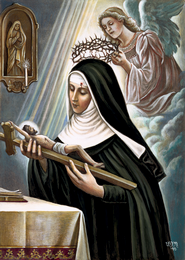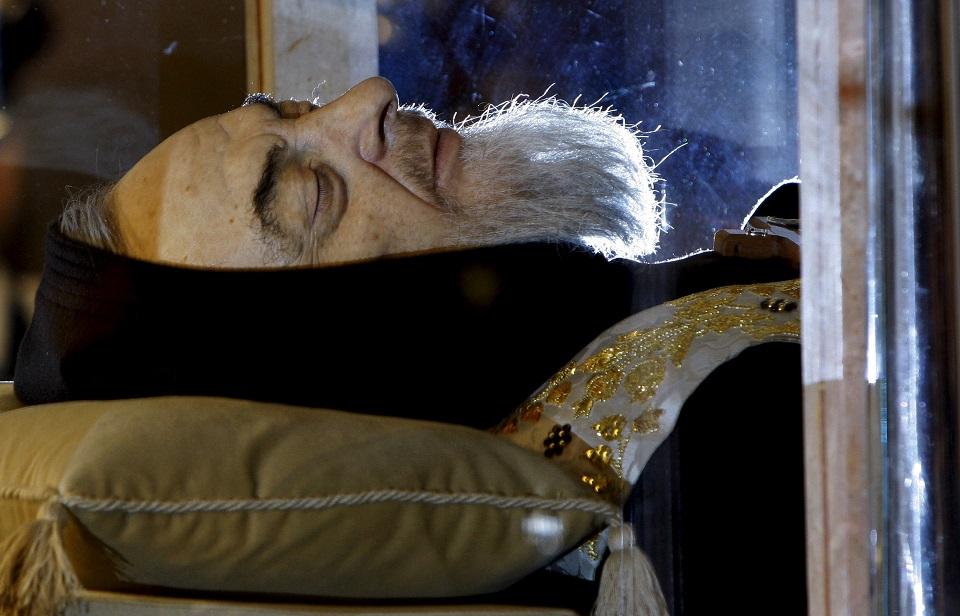“Trust all things to Jesus in the Blessed Sacrament and to Mary Help of Christians, and you will see what miracles are.” --St John Bosco
The gift of incorruption is considered to be one of God's highest honors bestowed upon those of exemplary holiness and saintly conduct. Catholics believe this to be miraculous, unexplainable to science, and a demonstration of God's power and promise that those who are faithful will one day be incorrupt themselves. Catholics put much emphasis upon venerating and honoring various relics and holy objects, as these relics often have direct association with holy people, places, or occurrences of the past. Relics are placed into one of three categories, with the most wondrous class being the first, which is comprised of bodies, flesh and bone. Naturally, the incorrupt remains of certain saints fall into this category. The Catholic Church that Christ founded upon the rock of St. Peter has deep roots that run through Italy, and still do to this day. After St Peter moved his seat to Rome in 44 AD, many popes that proceeded his position originated from the remarkable region of Italy. Catholicism is a massive part of Italian culture and identity, and a pillar of their way of life. It is then no surprise that some of the most marvelous and astounding physical manifestations of God's Divine intervention and love reside on the sunny peninsula. We will look at some of these amazing saints and the significance they have to the people of Italy and tourists alike.
St Cecilia
While there are over 100 confirmed cases of saints whose bodies resist the unpleasant course of nature after death, the very first known to receive this gift from God was St Cecilia. Born in a noble Roman family in an unknown year, she was given in marriage to a nobleman named Valerian. Cecilia, although being young and beautiful, desired to remain a virgin and was able to not only convince her new husband to help her fulfill this desire, but to convert him to her faith as well. It is said St Cecilia had invoked the help of her guardian angel to help protect her vow of chastity--this angel is said to have later appeared to Valerian and was a large part of what convinced him to convert to the true faith. Persecutors of Christianity eventually arrested her, her husband, and his brother. After her husband and his brother were beheaded, St Cecilia was ordered to be stifled with smoke, and yet after one day and one night was found to be unharmed and without even a sweat from the heat. She was then ordered to be beheaded by a skilled executioner, and yet even with the maximum allotted three blows he was unable to sever her head from her body. She remained alive for three days after, bleeding, praying, and preaching to people who visited her. She died in 177 AD, and her body was exhumed in 1599 and found to be remarkably preserved and accompanied by what was said to have been a delightful flower-like smell. St Cecilia was believed to have been found in the same position in which she had expired centuries prior, lying on her right side with her face turned downward with one finger extended on her left hand and three on her right. This was said to be a final profession of her faith in the Holy Trinity. Sculptor Stefano Maderno created a sculpture based upon her position at death, and it is one of the most popular Italian works of art. This can be seen in the Basilica of St Cecilia in Trastevere, Rome, Italy.

St Rita of Cascia
Born Margherita Lotti in 1381 near Umbria, Italy, Rita was known for her humility and patience as she aimed to convert her abusive husband and raise her two sons within the faith. After the death of her husband and sons, Rita desired as she always had to become a bride of Christ. Rita was canonzied by Pope Leo XIII on May 24, 1900 and is known to the people as the patron saint of impossible cases. She is one of few saints who are believed to have shared wounds with Christ from his crown of thorns. The Basilica of St. Rita at Cascia holds her incorrupt remains and is one of the most active pilgrimage sites in Umbria. Some report her remains to have moved and changed positions within the glass coffin unaided.

Padre Pio
Padre Pio was born in 1887 in Pietrelcina, Italy and was a devout priest of the Capuchin order. He was said to be blessed with many gifts in his lifetime such as the ability to read souls in his confessional and to perform healings. Perhaps the most significant was his reception of the stigmata, the five wounds suffered by Christ in his crucifixion. Pio was said to have bled from these wounds for the remainder of his life, and often was seen with bandages. Padre Pio adored the blessed sacrament during his masses and confessions for hours at a time. Upon his death he exclaimed, "I see two mothers." Many believe this to mean both his wordly mother, as well as the Blessed Virgin Mary. He was canonized in 2002, and his remains can be found at the Church of Our Lady of Grace in San Giovanni Rotondo, Italy.

St Paula Frassinetti
Born in Genoa, Italy, in 1809, St Paula came from a family of humble beginnings. Her mother died when she was only nine years old, leaving her to assume the responsibility of caring for her four brothers. All of her brothers eventually heard the call for the priesthood. She herself felt a call toward a life of vocation. She and 6 other women began what came to be known as the Sisters of St Dorothy. With what strength her physically exhausted body had left even at such a young age, she dedicated her life to teaching and providing for those in poverty and the ill. The order she had founded began to spread rapidly to Europe, Africa, Asia and even the Americas. Poverty and sickness often afflicted the sisters as they were too poor to afford any material and health assistance themselves. St Paula is known for her trust in God's plan despite overwhelming obstacles. As she would often say herself, "Will of God--My Paradise!" She was cannonized in 1984 and her remains are at rest at the Convent of St Dorotea in Rome.

St John Bosco
Known often to the people as Don Bosco, he was born in 1815 and felt a calling to the priesthood from a very young age. Being a poor shepherd boy, he lacked the necessary funds to pay for schooling, so his dream was often put on hold. After he was ordained a priest in Turin, he was in a constant state of work to build upon his passion of helping under privileged and struggling youth--especially when it came to education and orphanages. Having founded the religious order which was named the Salesians, which consisted of priests, brothers, and sisters, he was able to further expand missions and labor. Many would often tell St John Bosco to rest for but a little while from his exhausting endeavors, to which he would often reply, "First tell the devil to rest, and then I'll rest too." He was cannonized in 1934 and his body resides at the Basilica of Our Lady Help of Christians, whom to which St John Bosco had a deep devotion in his lifetime, in Turin, Italy.

Far from all saints were given the gift of incorruption, and for those people who were found to be incorrupt this did not always confer from the Holy Mother Church an automatic cannonization into sainthood. By looking into this miracle, we discover some interesting things about these incorrupt saints. The discovery of these saintly remains has often throughout history been seen with the exhumation of bodies--as they were often being moved to new locations. A common theme seen with many incorruptibles and noted by many who witnessed such events, comes what is known as the odor of sanctity. Many describe pleasant fragrance emanating from the caskets and bodies of the deceased, and since the bodies are pliable and many still contain soft tissues, this is surely remarkable. As human beings, we are often thought to be truly guided by our faith and not our sight. In some cases as noted with this concept of the odor of sanctity, our senses can be deeply intertwined with our faith.
It is not entirely known what has caused this incorruption in certain saints. Some may say that it is because that in their lifetime they were so pious and holy that it permeated their very flesh and bone, therefore it remains even long after their soul has left the physical body. Some believe that it is God's Divine Will rewarding them for a life spent and often given up to defend and demonstrate their love and devotion for Him. Some also do not believe in the validity of the incorrupt saints at all, often citing human intervention and scientific explanations for the preservation of the bodies. Oddly, attempts to explain this phenomenon with science often have been largely unsuccessful. Science only goes so far, and then comes God. One thing is for certain, to Catholics and followers of Christ, viewing the incorruptible saints can offer peace and consolation, and can inspire one to make the same choices as these saints and aspire to gain unearthly rewards as well.






